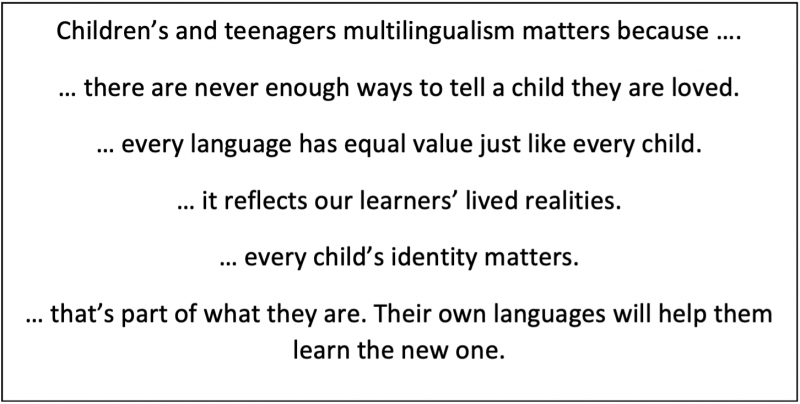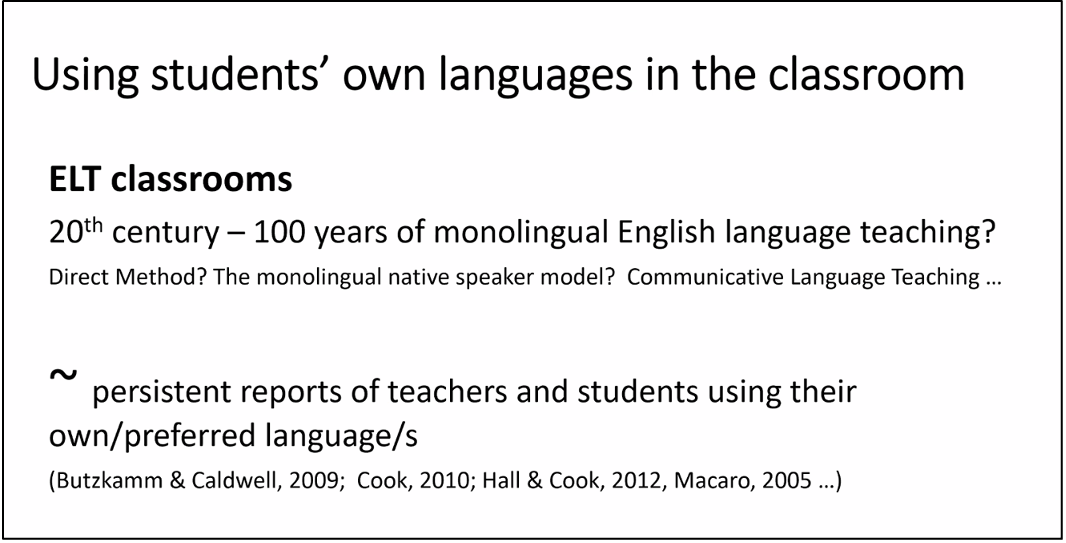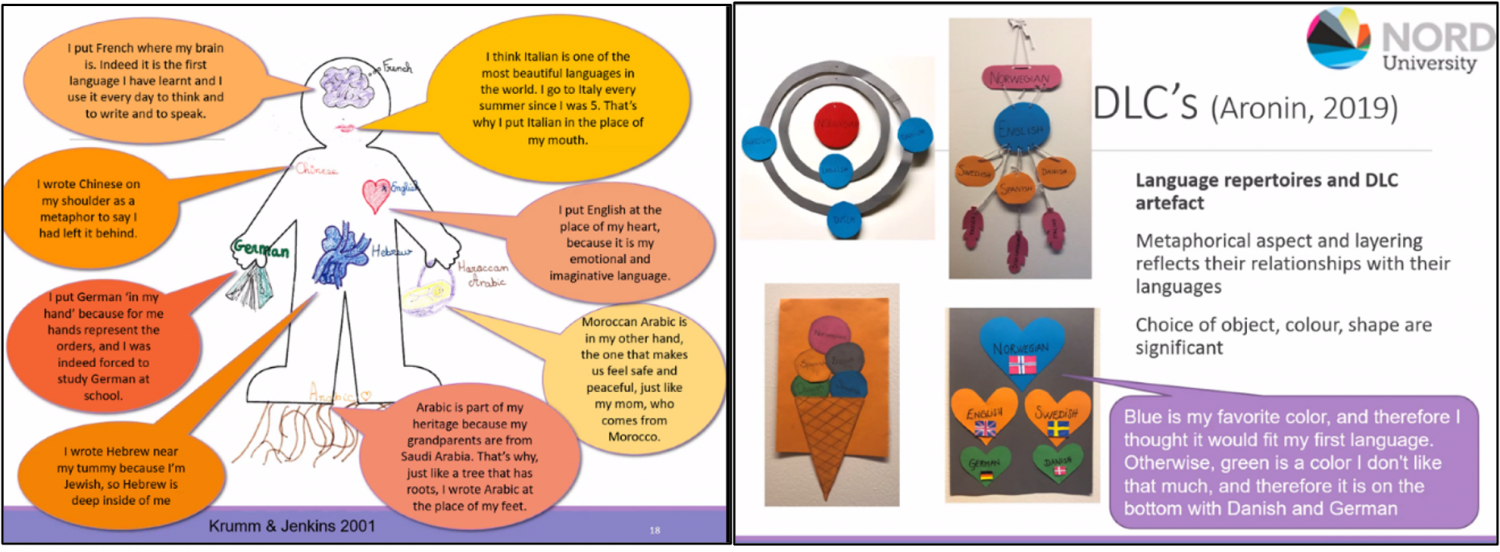While there have been talks at IATEFL conferences that have focused on the use of students’ own language(s) in the English language classroom, this PCE represents the first time that an IATEFL SIG has dedicated a full day to plurilingualism. This virtual event was held on 18 June with the following theme: Sharing languages: celebrating children’s and teenagers’ multilingualism in ELT, expertly explored by this line-up of high calibre speakers and sessions:
- Nayr Ibrahim’s opening plenary: Multilingual identities in monolingual classrooms: challenges and opportunities
- Lijuan Shi’s keynote: Bridging the language gap: Translanguaging pedagogy in early years settings
- Hamish Chalmers’ keynote: Leveraging language: The role of L1 in primary classrooms
- Constant Leung’s keynote: Using students’ own languages: policy and practice in EAL contexts
- Leketi Makalela’s closing plenary: Teaching English in a multilingual world: Ubuntu translanguaging and changing classroom terrains
There was also an inspire session by Canan Marasligil which showcased ways children and teenagers can creatively use their multilingual repertoires beyond the classroom. The planning for this event started back in 2019, and it was well worth waiting for as classrooms around the world are becoming more and more linguistically and culturally diverse. However, children’s and teenagers’ plurilingualism is largely ignored, forbidden, or even punished in certain ELT contexts. This rejection of students’ multilingual identities can impact negatively on their social, emotional, educational and personal development as well as their well-being.
In preparation for the event, participants were asked to complete the sentence (in any language(s) of their choice), ‘Children’s and teenagers’ multilingualism matters because …’ and to add these ideas to a Padlet wall. The event started with participants musing over the sentences (see Figure 1) and the recurring themes which emerged included children’s lived realities, equality, identity, respect and utility.

At this point, you might like to consider how you would complete the sentence yourself. As a former head of a large out-of-school English language provider for children and teenagers in Paris, I have reflected on the ways I might apply some of the content presented to such a setting. For a speaker-by-speaker synopsis, please see the summaries
by Amanda Davies publicly shared in the IATEFL YLTSIG Facebook Group.
Context
Paris is the most densely populated city and one of the most multilingual and multicultural places in Europe. The linguistic landscape in any one street reflects the many languages present in the daily lives of Parisians. However, mainstream education in France is conducted in the national language, French. This is the shared classroom language for most children / teenagers and proficiency in French is seen as the major instrument of integration. Many children / teenagers speak languages other than French at home, but these are mainly disregarded at school. English is still the most widely taught foreign language despite the introduction of a new strategy for languages in 2016 to offer greater diversity in the languages offered in schools.
Monolingual ideologies and archaic views of the bilingual mind
Monolingual ideologies, such as ‘English-only’ pedagogies, are promoted as unique selling points by private language schools based on the belief that immersion in the target language will result in better learning and meet customer expectations. The learner is viewed as an English language learner foremost rather than as an emergent bi/multilingual and is expected to exclude other languages from their learning to avoid interference. Archaic views of the bilingual mind still exist such as different languages occupying difference spaces in the brain and these spaces not overlapping, so the development of one language comes at a cost to development in the other.
However, despite ‘English only’ policies, own language(s) are used by learners regardless of what teachers do or say and they can also be used productively when children / teenagers work together in pairs or groups (Figure 2).

‘English only’ policies can impede learning by denying children and teenagers recourse to their linguistic repertoires as their own language is their default cognitive tool which they use to mediate their learning as they move from what is known to what is new. Teachers also use the shared classroom language and research suggests that 60 – 70% of word use in the student’s own language is not unusual.
With the above in mind, how then can a school convince:
- parents / caregivers of the value of bi/multilingualism when they are paying for a service where they expect their child / teen to be immersed in an English-only environment for two or three hours a week
- teachers who have no training in plurilingual practices and may have negative attitudes and perspectives towards building on the other languages children / teenagers may speak as a resource
- academic managers who use classroom observation criteria that disapproves of the use of the children’s / teenagers’ own language(s) by both students and teachers
in order to ensure that they work together to promote and maintain children’s / teenagers’ bi/multilingual abilities and cultural diversity?
Transparent communications and training
a) For parents and caregivers
Clear and transparent communications and training are required to manage expectations, to dispel myths about bi/multilingualism and help parents / caregivers to recognise and value the multilingual nature of societies, schools and classrooms in order to shift mindsets. Training courses and guides can provide this information such as how the principled use of the child’s / teen’s own language can support their English language learning. For example, explaining unfamiliar contexts or concepts, initiating conversations, translating, confirming and expanding student’s responses, teaching vocabulary and making cross linguistic comparisons.
b) For teachers and academic managers
An emphasis in ELT training courses on monolingual teaching approaches such as the communicative approach and the monolingual native speaker model (Figure 3) as well as decades of monolingualizing processes in society and education have meant that learners’ languages are too often discounted in the English language classroom.

Teachers and academic managers need enhanced training in bi/multilingual education to show how it is possible to demonoligualize ELT and bring children’s and teenagers’ languages and identities into the classroom. This process should begin with student teachers at the pre-service level by helping them become aware of and value their own multilingual repertoires. This includes their experience of all languages they may know no matter how much or how little they may use them. The aim is to shift attitudes from viewing bi/multilingualism as an obstacle to an asset and to gradually move away from monolingual practices.
Pedagogical approaches, techniques, activities, materials and resources
So, what pedagogical approaches, techniques, activities, materials and resources did the speakers propose that could be used in such a setting?
a) Approaches
- Pluralistic approaches and a pedagogy of noticing: for example, comparing English with the students’ own language(s) when learning new vocabulary and pronunciation and when working with picturebooks, promoting language awareness and understanding of the multilingual phenomenon, tangled translation where students use intercomprehension skills and look for cognates to guess words from another language interspersed within a text.
- Translanguaging: encouraging children and teenagers to alternate between languages for the purposes of receptive or productive use and going beyond occasional use of children’s / teenagers’ own language(s) so they become a tool for learning English, and learning English becomes a tool for expanding a child’s / teen’s holistic repertoire. It should also not be forgotten that translation is a favoured learning strategy by many learners.
- Humanistic and democratic practices: enabling students to work collaboratively and to use their own language(s):
- to say what they want to and talk about things they are interested in
- when reviewing learning in order to talk about this meaningfully
- for group work to prepare for a task in English
- for co-learning, i.e., learning with and from each other. Figure 4 shows Daniel, the teacher, asking Dongdong to correct his pronunciation of the Mandarin, ‘zise shui’. Dongdong’s, expression provides immediate feedback suggesting, ‘room for improvement’!

These practices give learners agency, choice and voice and valorise their languages. They create rapport and build on their prior knowledge, which includes their own language(s) and supports new learning as well as demonstrates their understanding of lesson content. Teachers should also recast key items in English when relevant.
b) Techniques and activities
We could use a plethora of multimodal techniques and activities including language trees, language portrait silhouettes, language repertoires, dominant language constellations, artefacts, language maps and word walls (see Figure 5 for examples). These techniques and activities are conducted in English and enable children and teenagers to identify or position themselves as multilinguals and make their languages visible and audible.

c) Resources and materials
We could additionally make use of these resources and materials: dual language picturebooks, multicultural literature, multilingual literacy corners. These all help us to promote equity and linguistic justice and to challenge the monolingual status quo.
A language centre can ask parents / caregivers to complete a profile on their child / teen to provide teachers with information about language(s) the child / teen speaks at home and their language learning experiences in formal or informal settings. A welcome sign can also be produced in the languages spoken by staff, students and the community to celebrate their languages and provide a visual and inclusive welcome. The CEFR was updated in 2020 to include plurilingual and pluricultural competence and reference to the ‘native speaker’ was removed. Language schools may therefore consider reviewing their job profiles to better recruit teachers who are competent in linguistically inclusive pedagogical practices.
An ancient and complex phenomenon
Multilingualism is complex, dynamic and multidimensional with many interlinking and overlapping aspects. If it is to be leveraged in the ELT classroom, teachers need to be equipped with the skills and attitudes to implement plurilingual practices. Clearly, there are challenges such as the balance between teaching English and developing emergent bi/multilinguals. However, children and teenagers feel valued when their bi/multilingual identities are acknowledged and celebrated (as I also did when the racist sign in Figure 6 was transformed into a positive message and included Cockney – I grew up in a Cockney-speaking family).

Anyone who attended this virtual event with a leaning towards a monolingual mindset at the start will undoubtedly have shifted to a multilingual mindset by the end. However, although multilingualism is a common and ancient phenomenon, there is an urgent need to promote plurilingual practices in ELT teacher education. The twenty-first century requires agile teachers (Figure 7) who are able to understand and adapt quickly to our complex and evolving environments. Teachers need to be inclusive of their learners’ linguistic and cultural diversity, recognise their multilingual identities and unleash their full potential in the English language classroom.

Many thanks to the IATEFL YLTSIG events team for organising this rich, stimulating and interactive virtual event.

